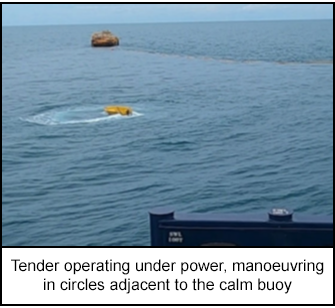-
What happened?
A tender was being used to transfer personnel from a tugboat to an offshore mooring point (calm buoy).
The tender was pushing up against the calm buoy ladder and as the last person stepped off, the tender slipped off the ladder and surged forward.
Consequently, the Coxswain lost balance and fell into the water.
The Coxswain was unharmed and was able to retrieve themself from the water by climbing up the ladder of the calm buoy, with assistance from the transferred personnel.
After the Coxswain entered the water, the unmanned tender continued to operate under power, manoeuvring in circles adjacent to the calm buoy.

-
Why did it happen?
The tender throttle lock had been applied whilst transferring personnel to the calm buoy.
The tender used for the transfer of personnel had a known defect with the “deadman” switch on the outboard motor.
The personnel and equipment transfer process involves pressing up the bow of the tender against a calm buoy ladder with only the coxswain remaining aft of the tender post transfer (impact on vessel stability).

-
What did they learn?
Review and assess the use of throttle lock applications on outboard motors and confirm that appropriate redundancy/fail-safe mechanisms have been installed and tested.
Test and confirm that equipment installed with safety-critical shut down apparatus is working correctly before use.
When performing transfers of personnel from tenders, consider allocation of crewing/ personnel to support stability.
Operators of outboard motors must have full control of the outboard motor at all times, with their hand placed firmly on the throttle control.

-
Ask yourself or your crew
Do you use tenders or small vessels to transfer personnel? Have you assessed the risks of single-person tender operations?
Are “kill switches” fitted on your outboard motors? Are they operational?
Does your planned maintenance schedule for tenders include regular checks, servicing, visual inspections and operational tests? Do you have a pre-departure checklist that you use before each transfer?
How do you manage vessel stability when transferring personnel in a small vessel/tender?
What controls do you have in place to respond to a person falling overboard? When did you last do an emergency response drill for this scenario?

Add to homescreen
Content name
Select existing category:
Content name
New collection
Edit collection
What happened?
A tender was being used to transfer personnel from a tugboat to an offshore mooring point (calm buoy).
The tender was pushing up against the calm buoy ladder and as the last person stepped off, the tender slipped off the ladder and surged forward.
Consequently, the Coxswain lost balance and fell into the water.
The Coxswain was unharmed and was able to retrieve themself from the water by climbing up the ladder of the calm buoy, with assistance from the transferred personnel.
After the Coxswain entered the water, the unmanned tender continued to operate under power, manoeuvring in circles adjacent to the calm buoy.

Why did it happen?
The tender throttle lock had been applied whilst transferring personnel to the calm buoy.
The tender used for the transfer of personnel had a known defect with the “deadman” switch on the outboard motor.
The personnel and equipment transfer process involves pressing up the bow of the tender against a calm buoy ladder with only the coxswain remaining aft of the tender post transfer (impact on vessel stability).
What did they learn?
Review and assess the use of throttle lock applications on outboard motors and confirm that appropriate redundancy/fail-safe mechanisms have been installed and tested.
Test and confirm that equipment installed with safety-critical shut down apparatus is working correctly before use.
When performing transfers of personnel from tenders, consider allocation of crewing/ personnel to support stability.
Operators of outboard motors must have full control of the outboard motor at all times, with their hand placed firmly on the throttle control.
Ask yourself or your crew
Do you use tenders or small vessels to transfer personnel? Have you assessed the risks of single-person tender operations?
Are “kill switches” fitted on your outboard motors? Are they operational?
Does your planned maintenance schedule for tenders include regular checks, servicing, visual inspections and operational tests? Do you have a pre-departure checklist that you use before each transfer?
How do you manage vessel stability when transferring personnel in a small vessel/tender?
What controls do you have in place to respond to a person falling overboard? When did you last do an emergency response drill for this scenario?
During a personnel transfer from a tugboat to an offshore mooring point, the tender slipped off the calm buoy ladder, causing the Coxswain to fall into the water. The Coxswain was unharmed and managed to climb back onto the buoy with assistance, while the unmanned tender continued to circle under power.
Original material courtesy of Safer Together (Australia)
To access the PDF and PowerPoint versions, please visit https://www.safertogether.com.au/resources/sharing-library/operating-a-vessel-person-overboard-leb-toolbox










